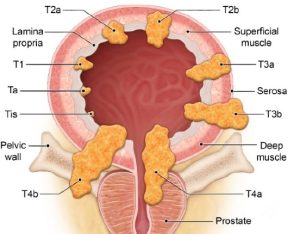Malignancy of Urinary Tract-Bladder
The common early symptom of bladder Malignancy (cancer) is blood in the urine. In most cases, the cancer is confined to the inside lining of the bladder. Treatment of these superficial bladder Malignancy (cancers) is relatively easy and often curative. If the cancer has spread into or through the muscle layer of the bladder wall then treatment is less likely to be curative, but can often slow the progress of the cancer.
Types of Transitional cell bladder cancer
- Superficial tumors. These occur in about 4 in 5 cases. These tumours are confined to the inner lining, or just below the inside lining, of the bladder. Sometimes the cells which form this type of cancer multiply to form little growths which stick out like warts from the inside lining of the bladder.
- Muscle invasive tumors. These occur in about 1 in 5 cases. These tumours have spread to the muscle layer of the bladder, or right through the wall of the bladder.
Causes of bladder cancer
- Increasing age. Most bladder cancers occur in people over the age of 50. It is rare in people aged younger than 40.
- Smoking. Bladder cancer is four times more common in smokers than non-smokers. Some of the chemicals from tobacco get into the body and are passed out in urine. These chemicals in the urine are carcinogenic (damaging) to the bladder cells. It is estimated that about one third of bladder cancers are related to smoking.
- Other chemicals. Certain workplace and environmental chemicals have been linked to bladder cancer – for example, substances used in the rubber and dye industries.
- Gender. Bladder cancer is about three times more common in men than women.
- Ethnic background. Bladder cancer is more common in white people than in black people.
- Food and drink. People who eat plenty of fruit and vegetables have a lower risk of developing bladder cancer than those who do not. Also, people who drink a lot of coffee have a slightly increased risk.
- Previous radiotherapy or chemotherapy increases the risk.
- Schistosomiasis. This bladder infection, which is caused by a parasite in certain hot countries, increases the risk.
- Repeated bouts of other types of bladder infection may also slightly increase the risk
Symptoms of bladder cancer
Blood in urine
In most cases, the first symptom is to pass blood in the urine (haematuria). Haematuria caused by an early bladder tumor is usually painless. You should always see your doctor if you pass blood in your urine. The blood in the urine may come and go as the tumor bleeds from time to time.
Other symptoms
Some tumours may cause irritation of the bladder and cause symptoms similar to a urine infection. For example, passing urine frequently or pain on passing urine. If the cancer is a muscle-invasive type, and grows through the wall of the bladder, then other symptoms may develop over time. For example, pain in the lower abdomen.
Treatment for Bladder Cancer
- Removal of the tumor
- Chemotherapy/immunotherapy
- Repeat checks
Hypernephroma
Hypernephroma or renal carcinoma accounts for 85% of renal neoplasms
Peak age 56 to 65 years, M:F = 2:1
Most are adenocarcinoma from proximal tubule
Prognosis old Bladder cancer
- Superficial bladder tumors. There is a good chance of a cure with treatment. Also, routine checks every few months following treatment will often detect recurrences early, and treatment can be repeated as necessary.
- Muscle-invasive bladder tumors. A cure is less likely than with a superficial tumor. As a rule, the earlier the stage of the tumor, the better the chance of a cure with the treatments listed above. However, even if it is not cured, treatment can often slow down the progression of the cancer.
medlight2u.com
- Presbyopia meaning “old eye”
- Oral cancer
- Gestational Trophoblastic Neoplasia (GTN)
- Brain tumors
- Perinatal Mood and Anxiety Disorders (PMADs)
Great content! Super high-quality! Keep it up!
I’m so in love with this. You did a great job!!
new texts were rewritten
The articles you write help me a lot and I like the topic
Acne Acne vulgaris Acute Renal Failure Adrenal cortex Angina Angina Pectoris Aortic Regurgitation (AR) Aortic Stenosis (AS) Chest pain Chronic pyelonephritis Coarctation of Aorta Cough cyanosis Cystic acne Dehydration depression Diabetes Mellitus Diagnosis of Aortic Stenosis Dr.KTS DR K TAMILSELVAN Fatigue Heart Failure Hypertension Hypokalemia Hypothyroidism Ischemic Heart Disease LBBB Mitral Incompetence Mitral insufficiency Mitral valve prolapse Nocturia Patent Ductus Arteriosus PDA Polyuria Proteinuria pulmonary hypertension Pulmonary Stenosis ST Depression Symptoms of Acne Syncope Treatment for acne valvular heart disease Ventricular Septal Defect VSD Zits




Can you write more about it? Your articles are always helpful to me. Thank you!